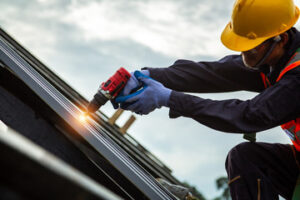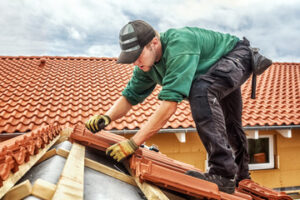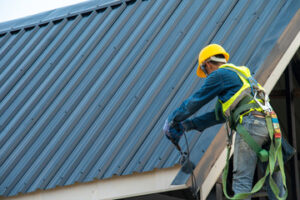Roofing professionals have an intimate understanding of quality products and building materials. They can also recommend the best materials for your roof, based on local weather conditions and the structure of the house.

Roofing Company Near Me has a good reputation in the community and offer excellent customer service. They will also have the necessary credentials and experience to complete a roofing job on time.
Roofing contractors install and repair roofs on new constructions, as well as existing homes and businesses. They can also work on major public structures such as schools or hospitals. Their job description may include installing skylights and utilising a variety of materials, from slates to tiles.
Experts in the field are licensed and insured, which is a good sign that they have the necessary knowledge to provide quality service. Additionally, they should have excellent communication skills to keep their clients updated on the project’s progress. In addition, they should be transparent about any additional costs that may arise during the process.
Honest Recommendations: A reliable contractor will offer honest advice about the best materials and methods for the job. They will not try to upsell services and will focus on what is truly required for a quality job. Clear Contracts: A reputable contractor will ensure that all aspects of the job are clearly outlined in a written contract, protecting both parties from any miscommunication.
Strong warranties and guarantees are important factors to consider when choosing a roofing company. Ask about the length and coverage specifics to make sure that you’re protected against unexpected expenses down the road. Ideally, warranties should be transferable when you sell your home, which will boost your resale value.
They can save you time
You can save time by hiring a roofing company that is licensed, bonded, and insured. It also helps to hire one that has extensive experience in the industry and can give you references from previous clients. This way, you can be confident that the roofer will provide quality service and a high-quality product. Also, make sure to ask the roofing company if they offer a warranty on their work. If they do, make sure it is transferable if you sell your home in the future.
Another way to save time is by choosing a roofing contractor who will get the job done right the first time. This will prevent the need for costly repairs and re-roofing. If you are unsure about the reputation of a roofer, check out online reviews from other homeowners. However, be careful with on-line reviews; sometimes companies pay to get positive reviews removed.
In addition to checking a roofing contractor’s license and insurance, you should make sure they are familiar with, and adhere to, your local building codes. This is essential to avoid costly code violations that can be expensive to fix. In addition, you should also avoid contractors who demand payment in cash; this will not only delay the project but may be a sign of fraud.
You should also consider hiring a roofing company that provides a full scope of work and estimate for the entire project. Detailed estimates will help you determine how much the project will cost and whether it is worth the investment. If the roofing contractor offers a warranty, you should also inquire about its length and coverage specifics.
To save yourself time and frustration, you must create an effective business management system that will allow you to free yourself from the daily grind of running a roofing company. Creating an accountability-based process will ensure that all tasks are completed on time and within budget. Learn more about this methodology with Breakthrough Academy’s free webinar on Goal Setting & Review (GSR) – click the link for details.
They can help you choose the right materials
Choosing the right roofing materials is an important step in ensuring that your roof is durable and weather resistant. A professional roofing contractor can help you select the best material based on your roof’s pitch and construction style. They can also advise you on which roofing materials are most suitable for your climate. For instance, asphalt shingles are a popular choice for residential homes and have a lifespan of 20 to 30 years. However, they may not be able to withstand heavy winds or snowfall. Other options include metal roofing, which is durable and can last for 50 years or more, and rubber and foam, which are eco-friendly and require less maintenance.
When evaluating roofing contractors, ask for references and examples of their work. Pay attention to how promptly and clearly they answer your questions, as this is an indication of their professionalism and customer service. Also, inquire about the warranty and guarantees that come with their services. A reputable roofing contractor should be willing to provide these details in writing.
The roofing contractor you choose should be licensed and insured to ensure that they comply with local building codes and standards. In addition, a well-established roofing company will have extensive experience and be able to handle any unexpected challenges that may arise during the project. They should also be able to offer warranties on their workmanship and materials.
Another consideration when selecting roofing materials is the cost and your budget. A professional roofing company can help you find the best materials for your home without exceeding your budget. They will also be able to provide you with a detailed estimate of the project, including labor and materials. The estimate should be itemized to prevent overcharges and include a breakdown of the costs.
Choosing the right roofing materials depends on several factors, including the structure’s construction style and your personal preferences. Some materials are more durable and require less maintenance than others, but they can be more expensive. Other factors to consider include the slope of the roof and how quickly water runs off it. If your business has a steep pitch, you will need to choose a more durable roofing material.
They can offer you a warranty
We’ve all been offered warranties on things like new cars and smart devices. But what about a warranty on your roof? It’s a great way to reduce your risks and expenses. Roofing companies can offer top-tier roof warranties to protect homeowners against damage and unforeseen costs. This type of warranty is a valuable investment for any homeowner. But before you decide to purchase a roof warranty, it’s important to know the details and conditions. A reputable roofing company will explain the terms of the warranty and answer your questions. They’ll also be able to provide references from previous clients who have used their services.
There are two main types of roof warranties: manufacturer and contractor warranties. Manufacturer warranties cover the materials used in the roof, such as shingles and other roofing products. Many manufacturers offer a limited lifetime warranty, but it’s important to read the fine print. These warranties typically cover material defects, and they may include shingle replacement and labor costs. Other important factors to consider when choosing a roofing warranty are duration, coverage details and the likelihood of a claim.
A contractor warranty covers the installation of the roofing product by the contractor. It covers issues such as shingle alignment, improper sealing and leaks. Some roofers offer workmanship warranties of one to ten years. The longer warranties can indicate a higher level of confidence in their work quality.
Roofing warranties can offer significant protection for your home and increase its value. Top-rated roofing warranties offer broader coverage and may require installation by certified contractors who meet high standards. They also cover full replacement costs in the event of component failure. In addition, they can transfer to a new owner, making them an excellent selling point. To maximize the benefits of a roof warranty, homeowners should schedule regular maintenance and professional inspections. In addition, they should always use the original roofing contractor for subsequent repairs as unauthorized work may void the warranty. Despite these limitations, a roofing warranty is an essential part of any roofing project.

